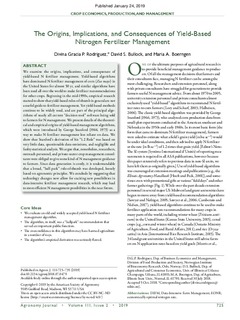| dc.contributor.author | Rodriguez, Divina Gracia P. | |
| dc.contributor.author | Bullock, David S. | |
| dc.contributor.author | Boerngen, Maria A. | |
| dc.date.accessioned | 2019-09-17T08:37:49Z | |
| dc.date.available | 2019-09-17T08:37:49Z | |
| dc.date.created | 2019-05-24T13:08:38Z | |
| dc.date.issued | 2019 | |
| dc.identifier.citation | Agronomy Journal. 2019, 111 (2), 725-735. | nb_NO |
| dc.identifier.issn | 0002-1962 | |
| dc.identifier.uri | http://hdl.handle.net/11250/2617147 | |
| dc.description.abstract | We examine the origins, implications, and consequences of yield-based N fertilizer management. Yield-based algorithms have dominated N fertilizer management of corn (Zea mays) in the United States for almost 50 yr, and similar algorithms have been used all over the world to make fertilizer recommendations for other crops. Beginning in the mid-1990s, empirical research started to show that yield-based rules-of-thumb in general are not a useful guide to fertilizer management. Yet yield-based methods continue to be widely used, and are part of the principal algorithms of nearly all current “decision tool” software being sold to farmers for N management. We present details of the theoretical and empirical origins of yield-based management algorithms, which were introduced by George Stanford (1966, 1973) as a way to make N fertilizer management less reliant on data. We show that Stanford’s derivation of his “1.2 Rule” was based on very little data, questionable data omissions, and negligible and faulty statistical analysis. We argue that, nonetheless, researchers, outreach personnel, and private-sector crop management consultants were obliged to give some kind of N management guidance to farmers. Since data generation is costly, it is understandable that a broad, “ball park” rule-of-thumb was developed, loosely based on agronomic principles. We conclude by suggesting that technology changes now allow for exciting new possibilities in data-intensive fertilizer management research, which may lead to more efficient N management possibilities in the near future. | nb_NO |
| dc.language.iso | eng | nb_NO |
| dc.rights | Attribution-NonCommercial-NoDerivatives 4.0 Internasjonal | * |
| dc.rights.uri | http://creativecommons.org/licenses/by-nc-nd/4.0/deed.no | * |
| dc.subject | DIFM | nb_NO |
| dc.subject | Data-Intensive Farm Management | nb_NO |
| dc.subject | EONR | nb_NO |
| dc.subject | Economically optimal nitrogen rate | nb_NO |
| dc.title | The Origins, Implications, and Consequences of Yield-Based Nitrogen Fertilizer Management | nb_NO |
| dc.type | Journal article | nb_NO |
| dc.type | Peer reviewed | nb_NO |
| dc.description.version | publishedVersion | nb_NO |
| dc.rights.holder | Copyright © 2019 by the American Society of Agronomy | nb_NO |
| dc.source.pagenumber | 725-735 | nb_NO |
| dc.source.volume | 111 | nb_NO |
| dc.source.journal | Agronomy Journal | nb_NO |
| dc.source.issue | 2 | nb_NO |
| dc.identifier.doi | 10.2134/agronj2018.07.0479 | |
| dc.identifier.cristin | 1700091 | |
| dc.relation.project | Andre: USDA Nat Inst of Food and Agr Food Sec Pr - 2016-68004-24769 | nb_NO |
| dc.relation.project | Andre: USDA NIFA’s Hatch Project 470-362 | nb_NO |
| cristin.unitcode | 7677,1,0,0 | |
| cristin.unitname | Divisjon for matproduksjon og samfunn | |
| cristin.ispublished | true | |
| cristin.fulltext | original | |
| cristin.qualitycode | 1 | |

